warning light Citroen DS4 RHD 2011.5 1.G User Guide
[x] Cancel search | Manufacturer: CITROEN, Model Year: 2011.5, Model line: DS4 RHD, Model: Citroen DS4 RHD 2011.5 1.GPages: 396, PDF Size: 12.14 MB
Page 178 of 396
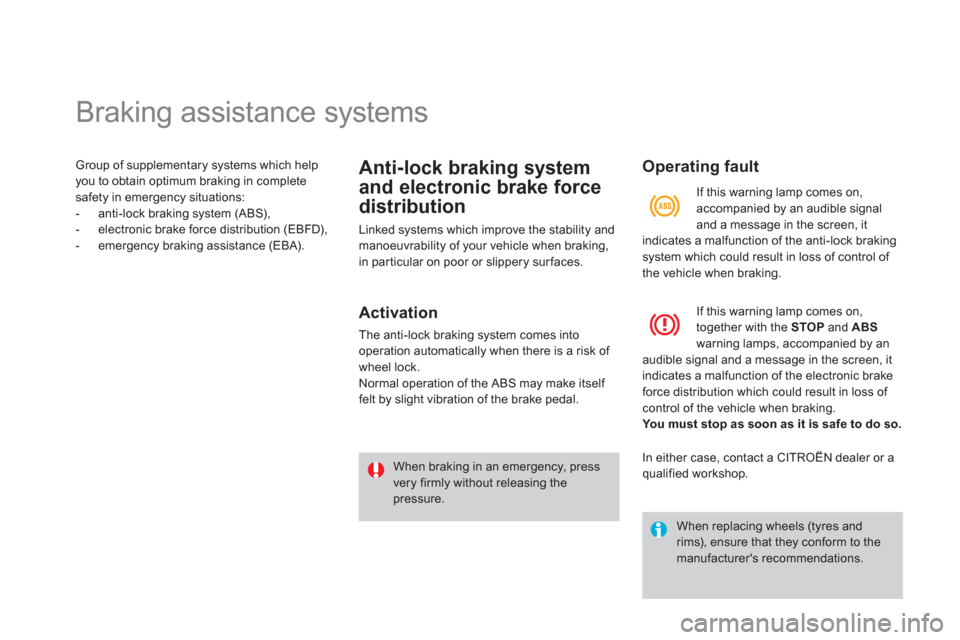
Braking assistance systems
Group of supplementary systems which helpyou to obtain optimum braking in complete safety in emergency situations:
- anti-lock braking system (ABS),
- electronic brake force distribution
(EBFD),
- emergency braking assistance (EBA).
Anti-lock braking system
and electronic brake force
distribution
Linked systems which improve the stability and
manoeuvrability of your vehicle when braking,
in par ticular on poor or slippery surfaces.
Activation
The anti-lock braking system comes into
operation automatically when there is a risk of
wheel lock.
Normal operation of the ABS may make itself
felt by slight vibration of the brake pedal.
When braking in an emergency, pressvery firmly without releasing thepressure.
Operating fault
If this warning lamp comes on,
together with the STOPand ABSwarning lamps, accompanied by an
audible signal and a message in the screen, it
indicates a malfunction of the electronic brake force distribution which could result in loss of control of the vehicle when braking.You must stop as soon as it is safe to do so.
When replacing wheels (tyres andrims), ensure that they conform to themanufacturer's recommendations.
If this warnin
g lamp comes on,
accompanied by an audible signaland a message in the screen, it
indicates a malfunction of the anti-lock brakingsystem which could result in loss of control of
the vehicle when braking.
In either case, contact a CITROËN dealer or a
qualified workshop.
Page 184 of 396
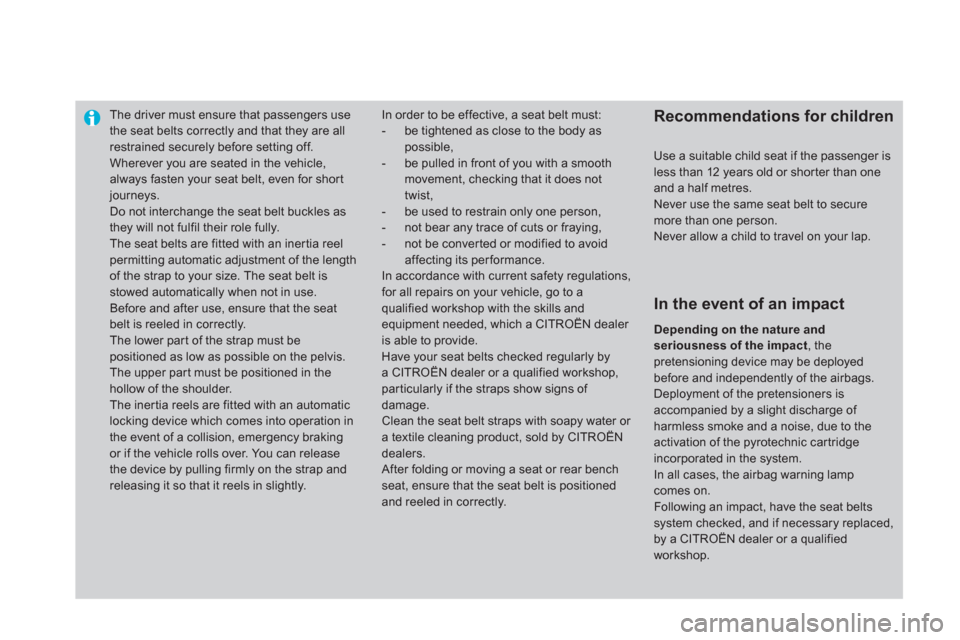
The driver must ensure that passengers usethe seat belts correctly and that they are allrestrained securely before setting off.
Wherever you are seated in the vehicle, always fasten your seat belt, even for short journeys. Do not interchange the seat belt buckles as they will not fulfil their role fully.
The seat belts are fitted with an inertia reel permitting automatic adjustment of the lengthof the strap to your size. The seat belt isstowed automatically when not in use.
Before and after use, ensure that the seatbelt is reeled in correctly.
The lower part of the strap must be positioned as low as possible on the pelvis.
The upper par t must be positioned in the hollow of the shoulder.
The inertia reels are fitted with an automatic locking device which comes into operation inthe event of a collision, emergency braking or if the vehicle rolls over. You can release the device by pulling firmly on the strap and releasing it so that it reels in slightly.
In order to be effective, a seat belt must:
- be tightened as close to the body as possible,
- be pulled in front of you with a smooth movement, checking that it does nottwist,
- be used to restrain only one person,
- not bear any trace of cuts or fraying,
- not be converted or modified to avoidaffecting its per formance.
In accordance with current safety regulations, for all repairs on your vehicle, go to aqualified workshop with the skills and equipment needed, which a CITROËN dealer is able to provide. Have your seat belts checked regularly by a CITROËN dealer or a qualified workshop, particularly if the straps show signs of damage.
Clean the seat belt straps with soapy water or a textile cleaning product, sold by CITROËN dealers.
After folding or moving a seat or rear benchseat, ensure that the seat belt is positioned and reeled in correctly.
Recommendations for children
Use a suitable child seat if the passenger is less than 12 years old or shor ter than one and a half metres.
Never use the same seat belt to secure more than one person.
Never allow a child to travel on your lap.
In the event of an impact
Depending on the nature andseriousness of the impact , the pretensioning device may be deployed before and independently of the airbags.Deployment of the pretensioners is accompanied by a slight discharge of harmless smoke and a noise, due to theactivation of the pyrotechnic cartridge incorporated in the system.
In all cases, the airbag warning lampcomes on.
Following an impact, have the seat beltssystem checked, and if necessary replaced, by a CITROËN dealer or a qualified workshop.
Page 212 of 396
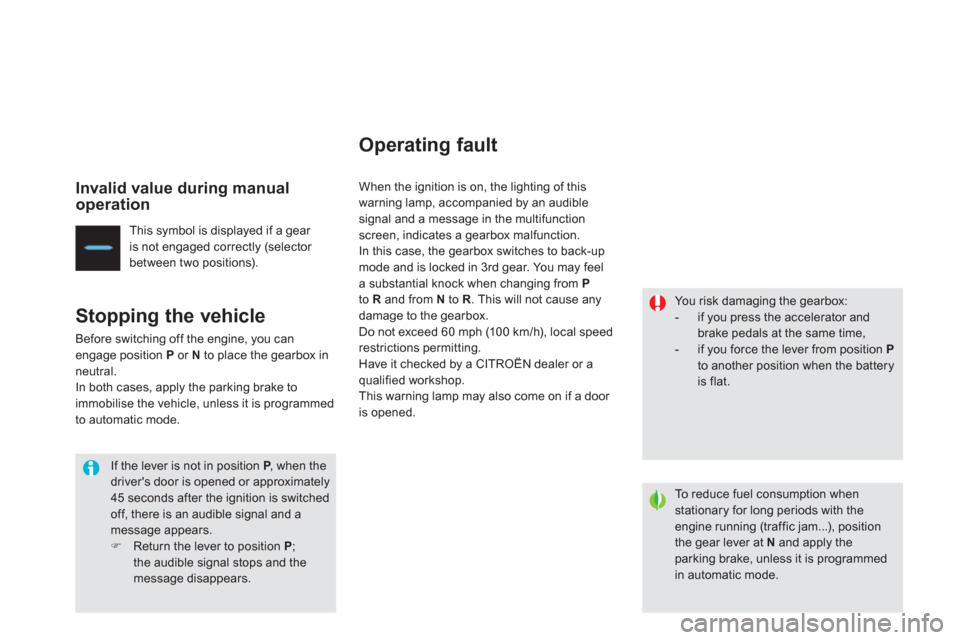
Invalid value during manualoperation
This symbol is displayed if a gear
is not engaged correctly (selector
between two positions).
Stopping the vehicle
Before switching off the engine, you canengage position Por N
to place the gearbox in neutral.
In both cases, apply the parking brake toimmobilise the vehicle, unless it is programmedto automatic mode.
If the lever is not in position P, when thePdriver's door is opened or approximately45 seconds after the ignition is switched off, there is an audible signal and amessage appears.�)Return the lever to position P
; the audible signal stops and themessage disappears.
Operating fault
When the ignition is on, the lighting of this
warning lamp, accompanied by an audible
signal and a message in the multifunction
screen, indicates a gearbox malfunction.
In this case, the gearbox switches to back-up
mode and is locked in 3rd
gear. You may feel
a substantial knock when changing from Pto R
and from N
to R
. This will not cause any
damage to the gearbox.
Do not exceed 60 mph (10 0 km/h), local speed restrictions permitting.
Have it checked by a CITROËN dealer or aqualified workshop.
This warning lamp may also come on if a door
is opened.
You risk damaging the gearbox:
- if you press the accelerator and brake pedals at the same time,
- if you force the lever from position Pto another position when the batteryis flat.
To reduce fuel consumption when stationary for long periods with the engine running (traffic jam...), positionthe gear lever at Nand apply theparking brake, unless it is programmed in automatic mode.
Page 214 of 396
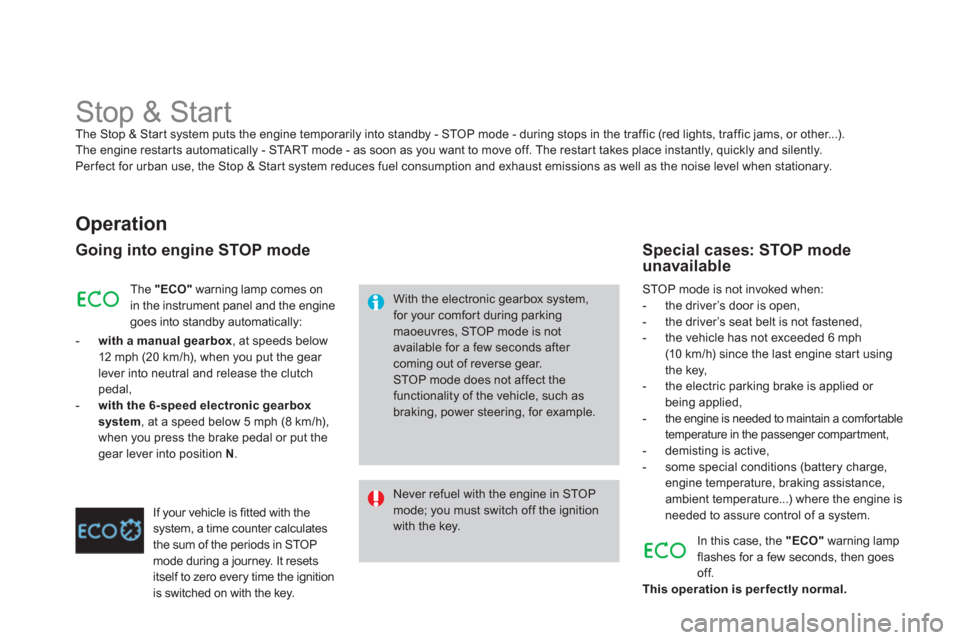
Stop & Start The Stop & Start system puts the engine temporarily into standby - STOP mode - during stops in the traffic (red lights, traffic jams, or other...).
The engine restar ts automatically - START mode - as soon as you want to move off. The restar t takes place instantly, quickly and silently.
Per
fect for urban use, the Stop & Star t system reduces fuel consumption and exhaust emissions as well as the noise level when stationary.
Operation
Going into engine STOP mode
With the electronic gearbox system, for your comfor t during parking maoeuvres, STOP mode is not available for a few seconds after coming out of reverse gear.STOP mode does not affect the functionality of the vehicle, such asbraking, power steering, for example.
Never refuel with the engine in STOPmode; you must switch off the ignition with the key. Th
e "ECO"warning lamp comes on
in the instrument panel and the engine goes into standby automatically:
-with a manual gearbox , at speeds below
12 mph (20 km/h), when you put the gear lever into neutral and release the clutchpedal,
- with the 6-speed electronic gearbox
system, at a speed below 5 mph (8 km/h),
when you press the brake pedal or put thegear lever into position N.
If your vehicle is fitted with the system, a time counter calculates
the sum o
f the periods in STOP
mode during a journey. It resets
itself to zero every time the ignition
is switched on with the key.
STOP mode is not invoked when:
- the driver’s door is open,
- the driver’s seat belt is not fastened,
- the vehicle has not exceeded 6 mph
(10 km/h) since the last engine start usingthe key,
- the electric parking brake is applied or
being applied,
-the engine is needed to maintain a comfortable
temperature in the passenger compartment,
- demisting is active,
- some special conditions (battery charge, engine temperature, braking assistance,ambient temperature...) where the engine isneeded to assure control of a system.
Special cases: STOP modeunavailable
In this case, the "ECO"
warning lamp
flashes for a few seconds, then goes off.
This operation is per fectly normal.
Page 218 of 396
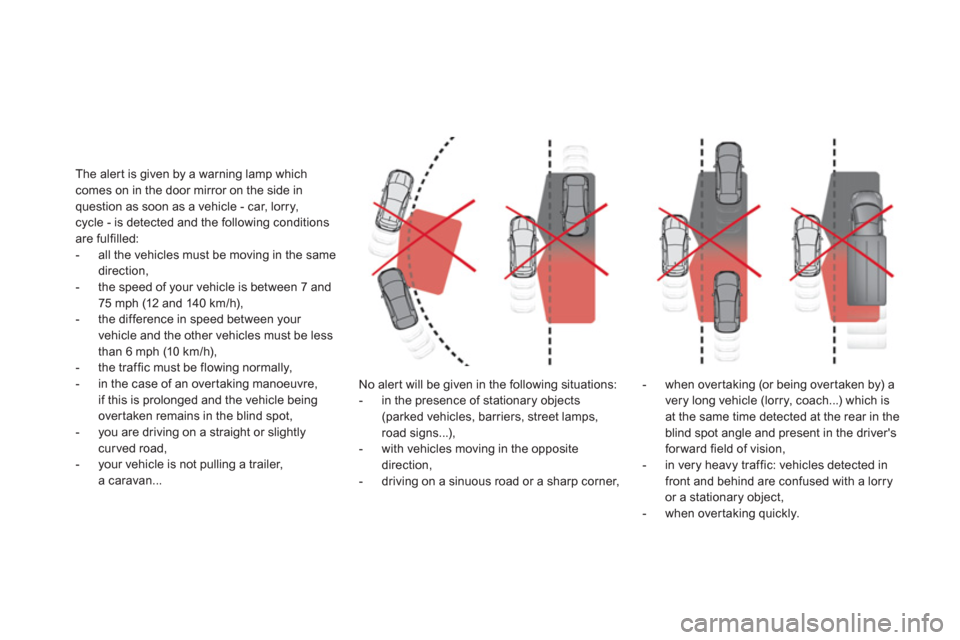
No aler t will be given in the following situations:
- in the presence of stationary objects(parked vehicles, barriers, street lamps,
road signs...),
- with vehicles moving in the opposite
direction,
- drivin
g on a sinuous road or a sharp corner,
The alert is given by a warning lamp whichcomes on in the door mirror on the side in
question as soon as a vehicle - car, lorry,cycle - is detected and the following conditions are fulfilled:
- all the vehicles must be moving in the same
direction,
- the speed of
your vehicle is between 7 and
75 mph (12 and 140 km/h),
- the difference in speed between your
vehicle and the other vehicles must be lessthan 6 mph (10 km/h),
- the traffic must be flowing normally,
- in the case of an overtaking manoeuvre,if this is prolonged and the vehicle being
over taken remains in the blind spot,
-
you are driving on a straight or slightlycurved road,- your vehicle is not pulling a trailer, a caravan...
- when overtakin
g (or being over taken by) a
very long vehicle (lorr y, coach...) which is at the same time detected at the rear in theblind spot angle and present in the driver's
for ward field of vision,
- in ver
y heavy traffic: vehicles detected in
front and behind are confused with a lorryor a stationary object,
- when overtaking quickly.
Page 280 of 396
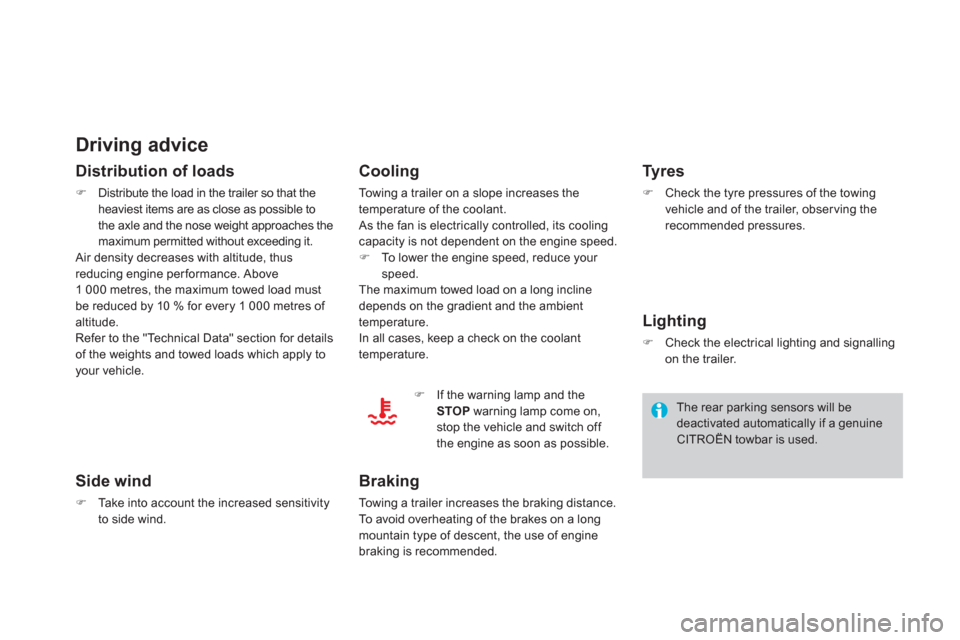
The rear parking sensors will be deactivated automatically if a genuine CITROËN towbar is used.
Driving advice
Distribution of loads
�)Distribute the load in the trailer so that theheaviest items are as close as possible to
the axle and the nose weight approaches the maximum permitted without exceeding it.
Air density decreases with altitude, thus reducing engine per formance. Above
1 000 metres, the maximum towed load must
be reduced b
y 10 % for every 1 000 metres of altitude.
Refer to the "Technical Data" section for details
of the weights and towed loads which apply to your vehicle.
Side wind
�)Take into account the increased sensitivity
to side wind.
Cooling
Towing a trailer on a slope increases the
temperature of the coolant.
As the fan is electrically controlled, its cooling capacity is not dependent on the engine speed.�)
To lower the engine speed, reduce your speed.
The maximum towed load on a long inclinedepends on the gradient and the ambient
temperature.
In all cases, keep a check on the coolant
temperature.
Braking
To w i ng a trailer increases the braking distance.
To a v o i d o v e r h e a t i ng of the brakes on a long
mountain type of descent, the use of enginebraking is recommended.
Tyres
�)Check the tyre pressures of the towing
vehicle and of the trailer, obser ving the recommended pressures.
Lighting
�)Check the electrical lighting and signalling on the trailer.
�)If the warning lamp and the
STOP warning lamp come on, stop the vehicle and switch off
t
he engine as soon as possible.
Page 287 of 396
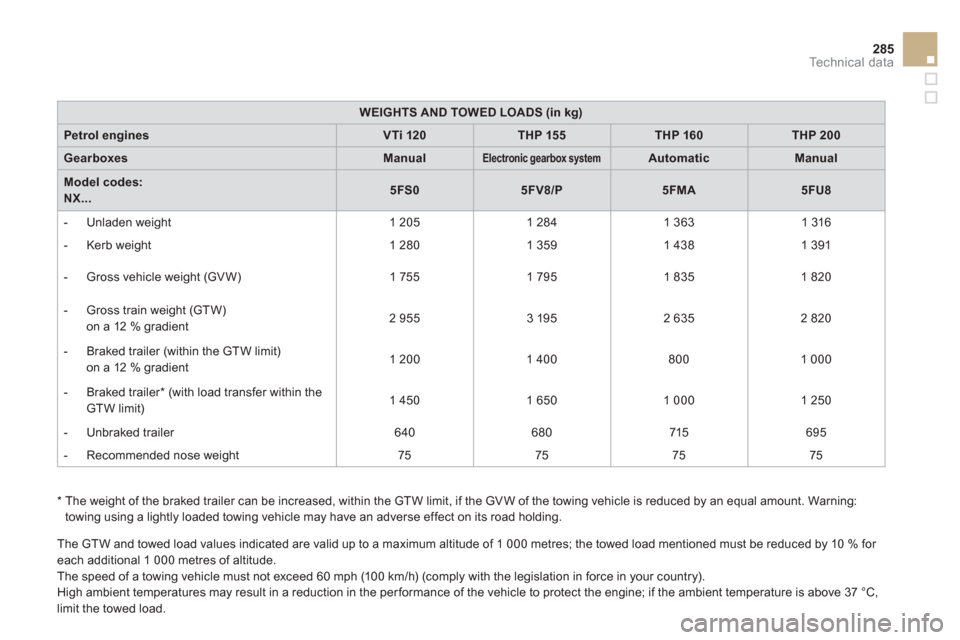
285
Technical data
WEIGHTS AND TOWED LOADS (in kg)
Petrol enginesVTi 120THP 155THP 160THP 200
GearboxesManualElectronic gearbox systemAutomaticManual
Model codes: NX...5FS05FV8/P5FMA5FU8
- Unladen wei
ght 1 2051 284 1 363
1 316
- Kerb weight 1 280
1 359
1 438
1 391
- Gross vehicle weight (GVW)
1 755
1 795
1 835
1 820
-
Gross train weight (GTW)
on a 12 % gradient
2 955
3 195
2 635
2 820
- Braked trailer
(within the GTW limit)
on a 12 % gradient 1 200
1 400
8001 000
- Braked trailer * (with load transfer within the
GTW limit) 1 4501 650 1 0001 250
- Unbraked trailer 640
680
715695
- Recommended nose weight
75
75
7575
*
The weight of the braked trailer can be increased, within the GTW limit, if the GV W of the towing vehicle is reduced by an equal amount. Warning:
towing using a lightly loaded towing vehicle may have an adverse effect on its road holding.
The
GTW and towed load values indicated are valid up to a maximum altitude of 1 000 metres; the towed load mentioned must be reduced by 10 % for each additional 1 000 metres of altitude.
The speed of a towing vehicle must not exceed 60 mph (10 0 km/h) (comply with the legislation in force in your country).
High ambient temperatures may result in a reduction in the performance of the vehicle to protect the engine; if the ambient temperature is above 37 °C,
limit the towed load.
Page 289 of 396
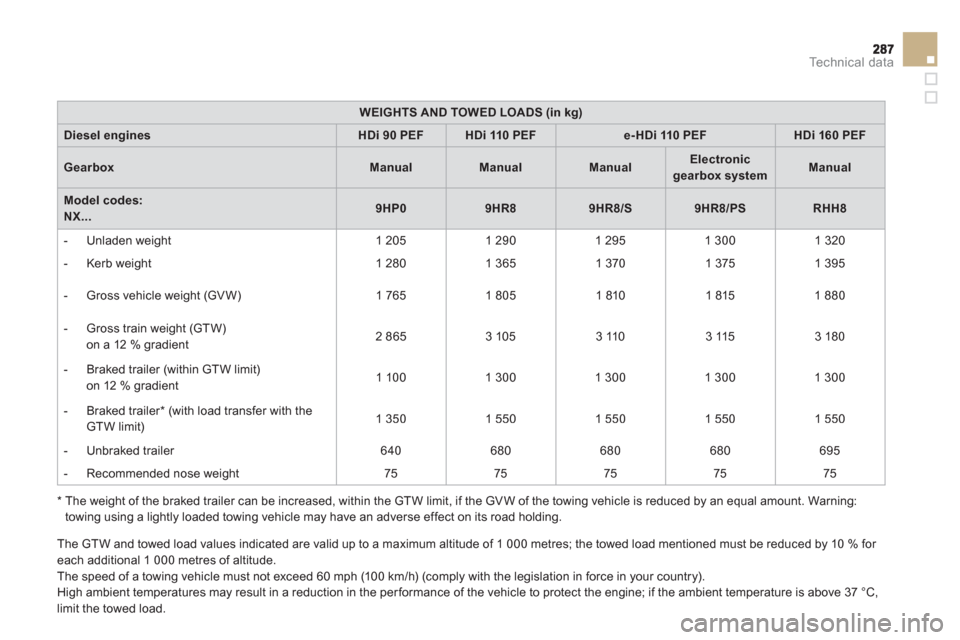
Technical data
WEIGHTS AND TOWED LOADS (in kg)
Diesel enginesHDi 90 PEFHDi 110 PEFe-HDi 110 PEFHDi 160 PEF
GearboxManualManualManualElectronic gearbox systemManual
Model codes:NX...9HP09HR89HR8/S9HR8/PSRHH8
- Unladen wei
ght 1 205 1 2901 295 1 3001 320
- Kerb weight 1 280 1 365
1 370 1 375
1 395
-
Gross vehicle weight (GVW)
1 765
1 805
1 8101 815
1 880
-
Gross train weight (GTW)
on a 12 % gradient
2 865
3 105
3 110
3 115
3 180
- Braked trailer
(within GTW limit) on 12 % gradient
1 100
1 300
1 300
1 300 1 300
- Braked trailer
*
(with load transfer with the
GTW limit)
1 3501 550
1 550
1 550
1 550
-
Unbraked trailer 640
680
680680695
- Recommended nose weight 75 75 75 75 75
*
The wei
ght of the braked trailer can be increased, within the GTW limit, if the GV W of the towing vehicle is reduced by an equal amount. Warning:
towing using a lightly loaded towing vehicle may have an adverse effect on its road holding.
The
GTW and towed load values indicated are valid up to a maximum altitude of 1 000 metres; the towed load mentioned must be reduced by 10 % for each additional 1 000 metres of altitude.
The speed of a towing vehicle must not exceed 60 mph (10 0 km/h) (comply with the legislation in force in your country).
High ambient temperatures may result in a reduction in the performance of the vehicle to protect the engine; if the ambient temperature is above 37 °C,
limit the towed load.
Page 384 of 396
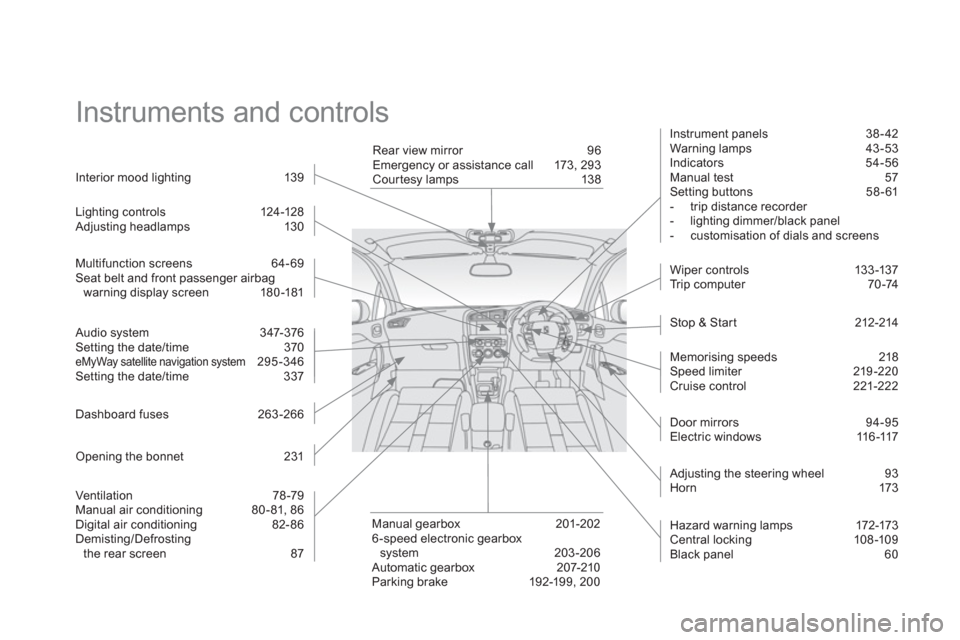
Instruments and controls Instrument panels 38 - 42
Warning lamps 43 -53
Indicators 54-56 Manual test 57 Setting buttons 58 - 61
- trip distance recorder
- lighting dimmer/black panel
- customisation of dials and screens
Stop & Star t 212-214 W iper c ontrols 13 3 -137
Trip computer 70 -74
Door mirrors
94-95
Electric windows 116-117
Hazard warnin
g lamps 172-173 Central locking 108 -109
Black panel 60
Adjusting the steering wheel 93
Horn 17
3 Multi
function screens 64- 69 Seat belt and front passenger airbagwarning display screen 18 0-181
Manual gearbox 201-202
6 -speed electronic gearbox
system 203-206
Automatic gearbox 207-210
Parking brake 192-199, 200 Interior mood li
ghting 13 9
R
ear view mirror 96
Emergency or assistance call 173, 293
Courtesy lamps 138
Ventilation 7
8-79
Manual air conditioning 80-81, 86
Digital air conditioning 82-86
Demisting/Defrostingthe rear screen 87
Audio system 347-376
Setting the date/time 370 eMyWay satellite navigation system295-346
Setting the date/time 337 Li
ghting controls 124-128
Adjusting headlamps 130
Dashboard fuses 2
63-266 Memorisin
g speeds 218 Speed limiter 219 -220 Cruise control 221-222
Opening the bonnet 231
Page 386 of 396
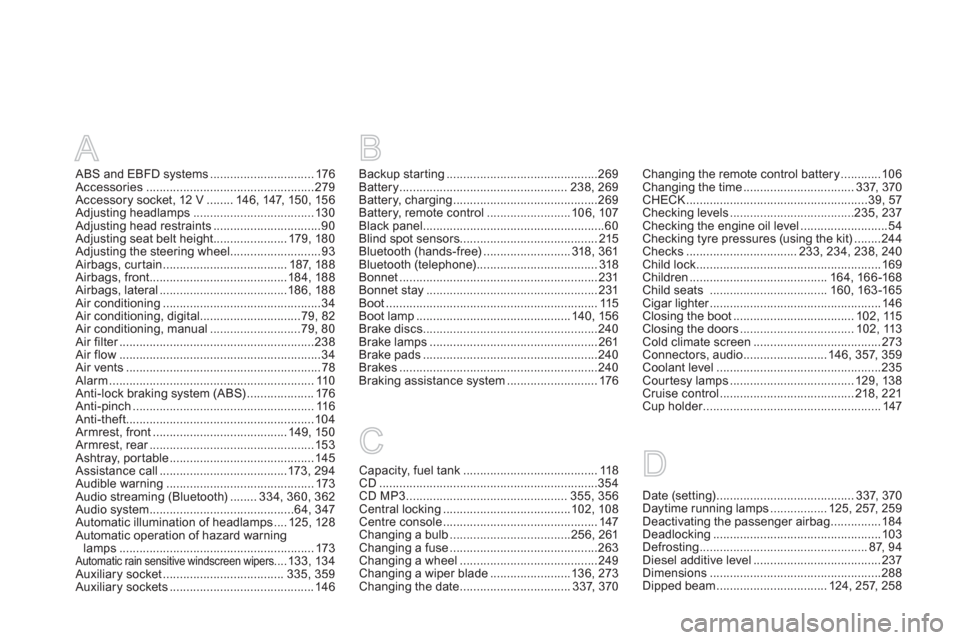
A
ABS and EBFD systems...............................176Accessories..................................................279Accessory socket, 12 V ........146, 147, 150,156Adjusting headlamps....................................130Adjusting head restraints ................................90Adjusting seat belt height ......................179, 180Adjusting the steering wheel...........................93Airbags, curtain.....................................187, 188Airbags, front.........................................184, 188Airbags, lateral......................................186, 188Air conditioning...............................................34Air conditioning, digital ..............................79,82Air conditioning, manual ...........................79,80Air filter..........................................................r238Air flow............................................................34Air vents ..........................................................78Alarm.............................................................110Anti-lock braking system (ABS)....................176Anti-pinch......................................................116Anti-theft........................................................104Armrest, front........................................149,150Armrest, rear.................................................r153Ashtray, por table...........................................145Assistance call ......................................173,294Audible warning ............................................ 173Audio streaming (Bluetooth)........334, 360, 362Audio system...........................................64, 347Automatic illumination of headlamps....125, 128Automatic operation of hazard warninglamps..........................................................173Automatic rain sensitive windscreen wipers....133,134Auxiliary socket ....................................335, 359Auxiliary sockets ...........................................146
Backup starting.............................................269Battery..................................................238, 269Battery, charging...........................................269Battery, remote control.........................106,107Black panel......................................................60Blind spot sensors.........................................215Bluetooth (hands-free)..........................318,361Bluetooth (telephone)....................................318Bonnet...........................................................231Bonnet stay...................................................231Boot...............................................................115Boot lamp..............................................140, 156Brake discs ....................................................240Brake lamps ..................................................261Brake pads ....................................................240Brakes ...........................................................240Braking assistance system...........................176
Capacity, fuel tank ........................................118CD .................................................................354CD MP3................................................355, 356Central locking......................................102,108Centre console..............................................147Changing a bulb....................................256,261Changing a fuse ............................................263Changing a wheel .........................................249Changing a wiper blade ........................136,273Changing the date.................................337, 370
Changing the remote control battery............106Changing the time.................................337,370CHECK......................................................39, 57Checking levels .....................................235,237Checking the engine oil level..........................54Checking tyre pressures (using the kit)........244Checks ................................. 233, 234, 238,240Child lock.......................................................169Children.........................................164, 166-168Child seats ...................................160,163-165Cigar lighter...................................................r146Closing the boot ....................................102, 115Closing the doors ..................................102,113Cold climate screen......................................273Connectors, audio .........................146,357, 359Coolant level.................................................235Courtesy lamps.....................................129, 138Cruise control........................................218,221Cup holder.....................................................r147
B
C
Date (setting).........................................337,370Daytime running lamps.................125,257, 259Deactivating the passenger airbag...............184Deadlocking..................................................103Defrosting ..................................................87, 94
Diesel additive level......................................237Dimensions...................................................288Dipped beam .................................124, 257, 258
D